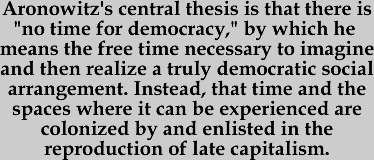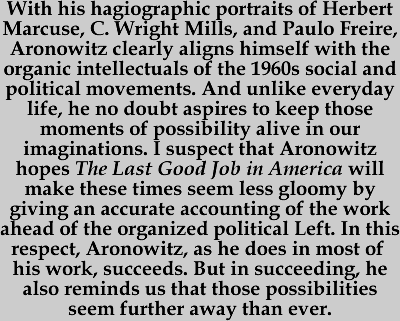![]()
The Last Good
Job in America: Work and Education in the New Global Technoculture by
Stanley Aronowitz
Rowman
& Littlefield, 2001
John Marsh
1.
One of the most prolific and insightful public intellectuals on the Left,
Stanley Aronowitz is also an unreconstructed radical, a part of (to borrow
a title of another of his books) The 60s without Apology. This
useable radical past is both Aronowitz's greatest asset, and, perhaps,
a source of despair for those of us born after the closing of the radical
political frontier. Over the years, however, Aronowitz has shown a remarkable
facility in a number of disciplines, publishing books on labor history,
higher education, and, more recently, science and technology. In The Last Good Job in America, he draws on this considerable
expertise for a wide-ranging set of essays that shows us to the penny
what late capitalism has taken from workers and educators, and why
that debt is likely to remain outstanding for the foreseeable future.
technology. In The Last Good Job in America, he draws on this considerable
expertise for a wide-ranging set of essays that shows us to the penny
what late capitalism has taken from workers and educators, and why
that debt is likely to remain outstanding for the foreseeable future.
2.
The opening piece, "No Time for Democracy," develops the categories—time,
space, and social change—that inform the rest of the book in one way or
another. Here, Aronowitz surveys the millennial world and finds it
disappointingly un-millennial. Instead of freedom from material scarcity,
which the philosopher and New Left acolyte Herbert Marcuse argued the
productive capacity of capitalism had made possible, we live in a world
beholden to an alienating and irrational economic and social arrangement. The
arrangement is irrational because it ensures only that we will devote
our lives—not just our work lives, but increasingly our leisure time as
well—to a system that will never liberate us from economic necessity and
thus never allow us to be free in any meaningful sense of the term. Aronowitz’s
intellectual hero, Marcuse, called it "a condition of relatively
comfortable unfreedom."
3.
Since the 1960s, however, that unfreedom has become decidedly less comfortable,
and perhaps even less free. Somewhere in Walden Thoreau warns
that you cannot kill time without injuring eternity. For Aronowitz,
late capitalism is serially murdering our time, and our concept of eternity
suffers accordingly. Aronowitz's central thesis is that there is
"no time for democracy," by which he means the free time necessary
to imagine and then realize a truly democratic social arrangement. Instead,
that time and the spaces where it can be experienced are colonized by
and enlisted in the reproduction of late capitalism. For example,
for most workers, the weekend is more endangered than some California
condors. We check our e-mail six times a day. We own enormous
homes that need to be repaired and remodeled. We commute hours to
work and hours back home. Some workers need two jobs to stay out
of poverty. And to Aronowitz's horror, some elementary schools, modeled
on the values of "business civilization," have even eliminated recess! They've
even gentrified Bohemia, for decades a space that could exist outside
of and thus implicitly rebuke the dictates of a work-and-spend career. We
live in an age, Aronowitz concludes, that has subsumed the human spirit—and
all its social spaces and work and leisure time—to the imperatives of
alienated work without end.
4.
In contrast, the last good job in America belongs, according to Aronowitz,
to Stanley Aronowitz, tenured sociology professor. His is a job that
pays relatively well, not only affords but rewards time off for reflection,
ensures job security, guarantees intellectual and political independence,
and, while by no means uncluttered, nevertheless remains largely self-directed.
It is indeed nice work if you can get it. And Aronowitz offers to
tell us how. Every job, he argues, should resemble that of a tenured
professor of sociology. "Rather than proposing an equality of
alienated labor, we should fight to universalize throughout society the
autonomy and shorter working hours of the senior professoriate at research
universities, not just for those in higher education" (36). Readers
of Workplace will no doubt agree. They will also agree with
Aronowitz that both inside and outside the academy, fewer and fewer jobs
are "good" by these standards. Instead, as he notes, "[t]his
is a time of work without end for many Americans and work shortage for
many others, especially youth, blacks, and other 'minorities,' and women
whose jobless rate is higher by a third than men's" (37).
5.
Still worse, alienated work-without-end combined with massive unemployment
has been accompanied by the lapse of any social movements that could challenge
the capitalist hegemony responsible for this now less comfortable unfreedom. The
social movements that previously threatened to rupture the uncritical
reproduction of capitalist social relations have either been exhausted
by the social-economic order they once sought to change or smoothly accommodated
into it. The once-vibrant Feminist movement, concerned with economic
justice and meaningful work for women, now limits itself to defending
abortion and dismantling the glass ceiling. Similarly, what remains
of the Civil Rights Movement is more concerned about access to capitalist
inequality than about eradicating it. Educational institutions have
not only jettisoned recess but, since it supposedly provides a reprieve
from business values, the higher education equivalent of recess, the humanities. Instead,
at all but the best research institutions, legislators and administrators
race to make higher education into advanced vocational programs and to
see which among them can make themselves more  attractive
to the "business community" and whatever remains of the state
and corporate funding that awaits the winners. And perhaps most dispiriting
for Aronowitz, the labor movement has "opted out of [its] historic
mission to end capitalism and its repressive social relations" (14). It
has opted instead for the decidedly less revolutionary mission of negotiating
contracts that trade away workers' control, grant huge wage-concessions,
or, worse still, it frets ineffectually over union jobs lost to automation
and runaway factories.
attractive
to the "business community" and whatever remains of the state
and corporate funding that awaits the winners. And perhaps most dispiriting
for Aronowitz, the labor movement has "opted out of [its] historic
mission to end capitalism and its repressive social relations" (14). It
has opted instead for the decidedly less revolutionary mission of negotiating
contracts that trade away workers' control, grant huge wage-concessions,
or, worse still, it frets ineffectually over union jobs lost to automation
and runaway factories.
6.
For Aronowitz, our only hope resides in revitalizing radical Left politics,
which can only be accomplished through social and political movements
that will open up new spaces of civil disobedience and utopian imagination. These
potential movements include unions, such as those that represent faculty
and graduate assistants, that will aim for more than what Samuel Gompers
once called unionism pure-and-simple—that is, an exclusive focus on wages
and benefits. These potential movements also include educators, who,
following the legacy of Paulo Freire and Antonio Gramsci, can act as organic
intellectuals and keep alive the possibility that another world is possible. Finally,
for Aronowitz, our best hope perhaps resides in the coalitions struggling
against corporate-directed globalization. Aronowitz even welcomes
the more radical elements of this movement, including the infamous anarchists
who were last seen swarming through downtown Seattle chucking rocks through
Starbucks’ windows, dismantling Niketown, and sending most of the U.S.
media into an embarrassing panic. Instead of the easy condemnation
that has greeted their efforts by even those on the Left, Aronowitz sees
in their rocks not only broken Starbucks' windows but, in some symbolic
propaganda of the deed, a break in the numbingly one-dimensional life
of late capitalism itself and a politics of last resort for young people
living without the radical alternatives earlier offered by the Communist
Party in the 1930s or Students for a Democratic Society in the 1960s.
7. The gloomy conclusion of Aronowitz's The Last Good Job in America is that we desperately need these union, education, and social and economic justice movements. With his hagiographic portraits of Herbert Marcuse, C. Wright Mills, and Paulo Freire, Aronowitz clearly aligns himself with the organic intellectuals of the 1960s social and political movements. And unlike everyday life, he no doubt aspires to keep those moments of possibility alive in our imaginations. I suspect that Aronowitz hopes The Last Good Job in America will make these times seem less gloomy by giving an accurate accounting of the work ahead of the organized political Left. In this respect, Aronowitz, as he does in most of his work, succeeds. But in succeeding, he also reminds us that those possibilities seem further away than ever. Alas, even Aronowitz recognizes that we will be waiting a long time indeed for our Lefties, New or New and Improved, and that the more this world is uncritically reproduced, so much more so do we lose even the capacity to imagine the better world those Lefties might usher in. Within the last years alone, terrorists have left most Americans longing for a return to "normalcy," the Left has rallied, pure and simply though necessarily, against war in Iraq, and state budgets, depleted by the economic recession, have threatened to complete the remaking of education into corporate feeding pools. In short, these are gloomy times indeed—and one wonders whether to praise Aronowitz for pointing this out, or despair that even the legacy of the 1960s may be no match for the realities of this new, so-far awful century.
